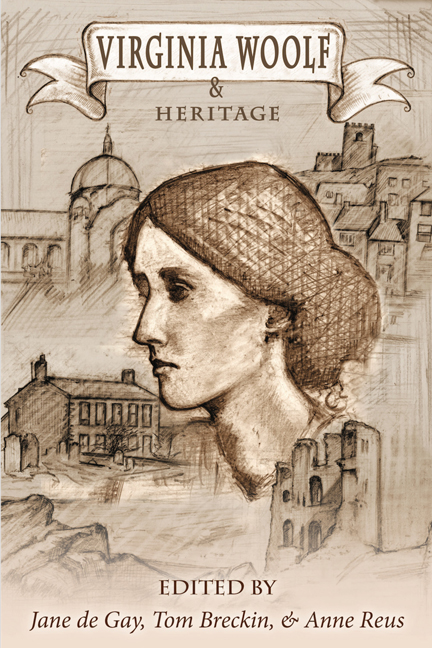Book contents
- Frontmatter
- Contents
- Introduction
- List of Abbreviations
- HERITAGE: A DEBATE
- HERITAGE, EDUCATION, AND MENTORING
- HERITAGE SPACES
- Virginia Woolf and the Artistic Heritage of St. Ives
- “The little bit of power I had myself ”: Lady Lasswade's Shifting Sense of Place in The Years
- Through the Arch: The Country House and the Tradition of English Tyranny in Woolf 's Between the Acts
- Heritage Hoarding: Artifacts, Archives, and Ambiguity, or, the Saga of Virginia Woolf 's Standing Desk
- “Against you I will fling myself, unvanquished and unyielding, O Death!”: Vanessa Bell's Death of the Moth Dust Jacket as Monument to Virginia Woolf
- LITERARY AND CULTURAL HERITAGES
- QUEER PASTS
- MODERNISM AND HERITAGE
- WRITING LIVES AND HISTORIES
- WOOLF'S LEGACIES
- FINALE
- Notes on Contributors
Through the Arch: The Country House and the Tradition of English Tyranny in Woolf 's Between the Acts
from HERITAGE SPACES
- Frontmatter
- Contents
- Introduction
- List of Abbreviations
- HERITAGE: A DEBATE
- HERITAGE, EDUCATION, AND MENTORING
- HERITAGE SPACES
- Virginia Woolf and the Artistic Heritage of St. Ives
- “The little bit of power I had myself ”: Lady Lasswade's Shifting Sense of Place in The Years
- Through the Arch: The Country House and the Tradition of English Tyranny in Woolf 's Between the Acts
- Heritage Hoarding: Artifacts, Archives, and Ambiguity, or, the Saga of Virginia Woolf 's Standing Desk
- “Against you I will fling myself, unvanquished and unyielding, O Death!”: Vanessa Bell's Death of the Moth Dust Jacket as Monument to Virginia Woolf
- LITERARY AND CULTURAL HERITAGES
- QUEER PASTS
- MODERNISM AND HERITAGE
- WRITING LIVES AND HISTORIES
- WOOLF'S LEGACIES
- FINALE
- Notes on Contributors
Summary
In his biography of Lytton Strachey, Michael Holroyd reports that in 1929 Strachey's long-time companion, Dora Carrington, designed “an imitation bookcase over an unused door at Ham Spray with a series of ironic titles (The Empty Room by Virginia Woolf, The Lad by Leonard Woolf, and the ambitious Deeds Not Words volumes I & II by A. Carpenter)” (619). Carrington no doubt fashioned titles to signal themes dear to each author, and to enjoy a bit of an inside joke. Empty rooms do figure prominently in Virginia Woolf 's writing: consider Jacob's Room, A Room of One's Own, or the empty rooms in the “Time Passes” section of To the Lighthouse, among many other examples. Yet Woolf 's interest went far beyond rooms to domestic space in general, and the English country house in particular. A brief survey of the appearance of great houses in Woolf 's writing reveals this: Mrs. Dalloway, To the Lighthouse, Orlando, The Years, and Between the Acts, all feature great houses. Gina Wisker maintains that Woolf 's houses reflect versions of what she calls “the English country house tradition,” as they “emphasise values of continuity and harmony, or undercut and question them” (5).
That the English country house embodies only national unity, order and stability is, as Wisker's comment suggests, a myth. Reminding readers that English great houses have always been “permeated by forces of colonial wealth and influence,” Leena Kore Schröder suggests that in Between the Acts,
Woolf constructs the nostalgic image of the English country house in full awareness of its status as myth. She invokes the country house image not as an empty emotional gesture towards some idyllic past, but in order to reveal the diversity of what flows through it. (270)
Woolf 's portrait of Pointz Hall, the country house belonging to the Olivers in Between the Acts, engages with this myth, emphasizing the permeability of the English country house and demonstrating her much-cited claim that “the public and the private worlds are inseparably connected; the tyrannies and servilities of the one are the tyrannies and servilities of the other” (TG 142–3). Writing this in the early days of World War II, Woolf was acutely aware of the perils around her.
- Type
- Chapter
- Information
- Virginia Woolf and Heritage , pp. 67 - 72Publisher: Liverpool University PressPrint publication year: 2017



